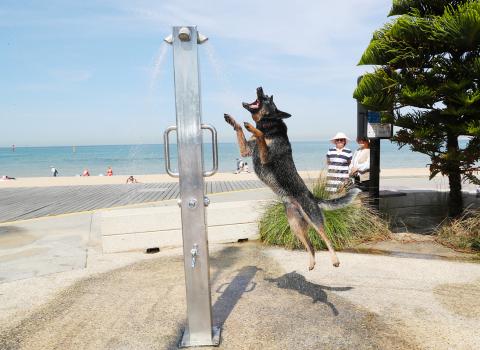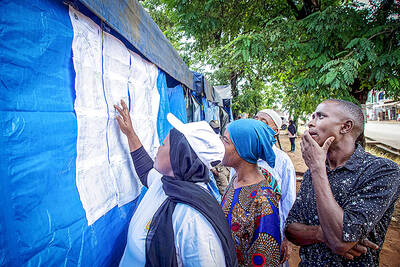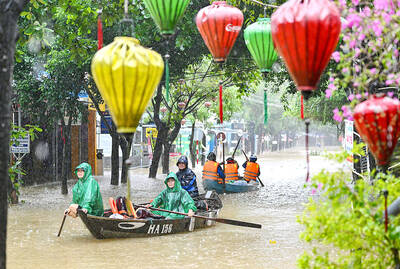Australia this week experienced its hottest day on record and the heat wave is expected to worsen, exacerbating an already unprecedented bushfire season, authorities said yesterday.
The average nationwide temperature of 40.9°C on Tuesday beat the previous record of 40.3°C in January 2013, the Australian Bureau of Meteorology said.
“This heat will only intensify further today [Wednesday],” meteorologist Diana Eadie said.

Photo: EPA-EFE
The heat wave is another alarm bell about global warming in Australia, where this year’s early and intense start to regular summer bushfires has heaped pressure on the Australian government to do more to tackle climate change.
Hundreds of bushfires have been raging across Australia for months, including a “mega-blaze” burning north of Sydney.
Smoke from the fires has engulfed Sydney, raising air pollution to hazardous levels in an event that leading doctors have labeled a “public health emergency.”
At least 3 million hectares of land has been torched across Australia, with six people killed and about 700 homes destroyed.
Scientists have said that the blazes have come earlier and with more intensity than usual due to global warming, and a prolonged drought that has left the land dry and many towns running out of water.
The fires have sparked climate protests targeting the conservative government, which has resisted pressure to address the root causes of global warming to protect the country’s lucrative coal export industry.
Record spot temperatures were recorded this week in western Australia, where firefighters have also been battling blazes raging across thousands of hectares of land.
The hot weather is drifting across the country’s arid center toward the east.
Temperatures in parts of New South Wales are forecast to reach about 45°C today, while those in western Sydney are due to reach more than 46°C as conditions worsen on Saturday.
Turbulent winds of up to 100kph are forecast to also hit the eastern coast and worsen the blazes.
“Over the next few days, we are going to see firefighters, the emergency services and all those communities close to fires ... challenged with a new threat,” New South Wales Rural Fire Service Commissioner Shane Fitzsimmons said yesterday.
Embers carried by the winds can travel up to 30km from a blaze, authorities said.
“We are going to have a number of fronts that are going to fuel or escalate the fires burning, but also the potential to have spot fires and embers traveling very long distances,” New South Wales Premier Gladys Berejiklian said.
Australian Prime Minister Scott Morrison last week made a rare admission that climate change was one of the “factors” behind the fires, but he defended the government’s record on emissions reduction and failed to announce additional measures to address the issue.
Climate protesters plan to march on Morrison’s official residence in Sydney this week to rally for change and highlight his absence as large parts of the country burn. Morrison is vacationing at an undisclosed location overseas.

With much pomp and circumstance, Cairo is today to inaugurate the long-awaited Grand Egyptian Museum (GEM), widely presented as the crowning jewel on authorities’ efforts to overhaul the country’s vital tourism industry. With a panoramic view of the Giza pyramids plateau, the museum houses thousands of artifacts spanning more than 5,000 years of Egyptian antiquity at a whopping cost of more than US$1 billion. More than two decades in the making, the ultra-modern museum anticipates 5 million visitors annually, with never-before-seen relics on display. In the run-up to the grand opening, Egyptian media and official statements have hailed the “historic moment,” describing the

‘CHILD PORNOGRAPHY’: The doll on Shein’s Web site measure about 80cm in height, and it was holding a teddy bear in a photo published by a daily newspaper France’s anti-fraud unit on Saturday said it had reported Asian e-commerce giant Shein (希音) for selling what it described as “sex dolls with a childlike appearance.” The French Directorate General for Competition, Consumer Affairs and Fraud Control (DGCCRF) said in a statement that the “description and categorization” of the items on Shein’s Web site “make it difficult to doubt the child pornography nature of the content.” Shortly after the statement, Shein announced that the dolls in question had been withdrawn from its platform and that it had launched an internal inquiry. On its Web site, Le Parisien daily published a

UNCERTAIN TOLLS: Images on social media showed small protests that escalated, with reports of police shooting live rounds as polling stations were targeted Tanzania yesterday was on lockdown with a communications blackout, a day after elections turned into violent chaos with unconfirmed reports of many dead. Tanzanian President Samia Suluhu Hassan had sought to solidify her position and silence criticism within her party in the virtually uncontested polls, with the main challengers either jailed or disqualified. In the run-up, rights groups condemned a “wave of terror” in the east African nation, which has seen a string of high-profile abductions that ramped up in the final days. A heavy security presence on Wednesday failed to deter hundreds protesting in economic hub Dar es Salaam and elsewhere, some

Flooding in Vietnam has killed at least 10 people this week as the water level of a major river near tourist landmarks reached a 60-year high, authorities said yesterday. Vietnam’s coastal provinces, home to UNESCO world heritage site Hoi An ancient town, have been pummeled by heavy rain since the weekend, with a record of up to 1.7m falling over 24 hours. At least 10 people have been killed, while eight others are missing, the Vietnamese Ministry of Natural Resources and Environment said. More than 128,000 houses in five central provinces have been inundated, with water 3m deep in some areas. People waded through